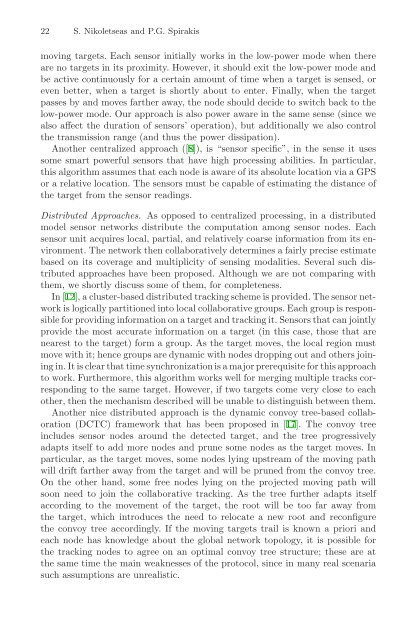Lecture Notes in Computer Science 4837
Lecture Notes in Computer Science 4837
Lecture Notes in Computer Science 4837
You also want an ePaper? Increase the reach of your titles
YUMPU automatically turns print PDFs into web optimized ePapers that Google loves.
22 S. Nikoletseas and P.G. Spirakis<br />
mov<strong>in</strong>g targets. Each sensor <strong>in</strong>itially works <strong>in</strong> the low-power mode when there<br />
are no targets <strong>in</strong> its proximity. However, it should exit the low-power mode and<br />
be active cont<strong>in</strong>uously for a certa<strong>in</strong> amount of time when a target is sensed, or<br />
even better, when a target is shortly about to enter. F<strong>in</strong>ally, when the target<br />
passes by and moves farther away, the node should decide to switch back to the<br />
low-power mode. Our approach is also power aware <strong>in</strong> the same sense (s<strong>in</strong>ce we<br />
also affect the duration of sensors’ operation), but additionally we also control<br />
the transmission range (and thus the power dissipation).<br />
Another centralized approach ([8]), is “sensor specific”, <strong>in</strong> the sense it uses<br />
some smart powerful sensors that have high process<strong>in</strong>g abilities. In particular,<br />
this algorithm assumes that each node is aware of its absolute location via a GPS<br />
or a relative location. The sensors must be capable of estimat<strong>in</strong>g the distance of<br />
the target from the sensor read<strong>in</strong>gs.<br />
Distributed Approaches. As opposed to centralized process<strong>in</strong>g, <strong>in</strong> a distributed<br />
model sensor networks distribute the computation among sensor nodes. Each<br />
sensor unit acquires local, partial, and relatively coarse <strong>in</strong>formation from its environment.<br />
The network then collaboratively determ<strong>in</strong>es a fairly precise estimate<br />
based on its coverage and multiplicity of sens<strong>in</strong>g modalities. Several such distributed<br />
approaches have been proposed. Although we are not compar<strong>in</strong>g with<br />
them, we shortly discuss some of them, for completeness.<br />
In [12], a cluster-based distributed track<strong>in</strong>g scheme is provided. The sensor network<br />
is logically partitioned <strong>in</strong>to local collaborative groups. Each group is responsible<br />
for provid<strong>in</strong>g <strong>in</strong>formation on a target and track<strong>in</strong>g it. Sensors that can jo<strong>in</strong>tly<br />
provide the most accurate <strong>in</strong>formation on a target (<strong>in</strong> this case, those that are<br />
nearest to the target) form a group. As the target moves, the local region must<br />
move with it; hence groups are dynamic with nodes dropp<strong>in</strong>g out and others jo<strong>in</strong><strong>in</strong>g<br />
<strong>in</strong>. It is clear that time synchronization is a major prerequisite for this approach<br />
to work. Furthermore, this algorithm works well for merg<strong>in</strong>g multiple tracks correspond<strong>in</strong>g<br />
to the same target. However, if two targets come very close to each<br />
other, then the mechanism described will be unable to dist<strong>in</strong>guish between them.<br />
Another nice distributed approach is the dynamic convoy tree-based collaboration<br />
(DCTC) framework that has been proposed <strong>in</strong> [17]. The convoy tree<br />
<strong>in</strong>cludes sensor nodes around the detected target, and the tree progressively<br />
adapts itself to add more nodes and prune some nodes as the target moves. In<br />
particular, as the target moves, some nodes ly<strong>in</strong>g upstream of the mov<strong>in</strong>g path<br />
will drift farther away from the target and will be pruned from the convoy tree.<br />
On the other hand, some free nodes ly<strong>in</strong>g on the projected mov<strong>in</strong>g path will<br />
soon need to jo<strong>in</strong> the collaborative track<strong>in</strong>g. As the tree further adapts itself<br />
accord<strong>in</strong>g to the movement of the target, the root will be too far away from<br />
the target, which <strong>in</strong>troduces the need to relocate a new root and reconfigure<br />
the convoy tree accord<strong>in</strong>gly. If the mov<strong>in</strong>g targets trail is known a priori and<br />
each node has knowledge about the global network topology, it is possible for<br />
the track<strong>in</strong>g nodes to agree on an optimal convoy tree structure; these are at<br />
the same time the ma<strong>in</strong> weaknesses of the protocol, s<strong>in</strong>ce <strong>in</strong> many real scenaria<br />
such assumptions are unrealistic.
















